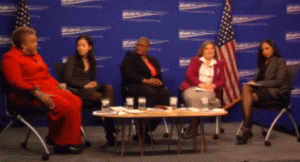 I’ve known the statistic for a long time, but it never ceases to amaze me each time I see it in black and white: just 4.5 percent of members of Congress are women of color. Out of 535 people, there are 13 African American women, seven Latinas, and four Asian Pacific American women. That’s not a minority – it’s a minisculority (if such a word existed). The issue, of course, is that women of color make up 18.4 percent of the US population. It makes you wonder when the House of Representatives – and all of the other branches of government – will actually represent all of the American people.
I’ve known the statistic for a long time, but it never ceases to amaze me each time I see it in black and white: just 4.5 percent of members of Congress are women of color. Out of 535 people, there are 13 African American women, seven Latinas, and four Asian Pacific American women. That’s not a minority – it’s a minisculority (if such a word existed). The issue, of course, is that women of color make up 18.4 percent of the US population. It makes you wonder when the House of Representatives – and all of the other branches of government – will actually represent all of the American people.
The disparity in population and representation is evident outside of the world of politics, too. Latinas make up just five percent of Fortune 500 boards. According to Catalyst, two-thirds of Fortune 500 companies have no women of color on their boards (10 percent have no women at all!). And while the number of women of color who are CEOs at Fortune 500 companies fluctuates year-to-year, there are never more than a handful.
Earlier this month, the Center for American Progress brought together a diverse group of women to have a conversation about leadership, mentoring, executive presence and the changing face of female influence. At the heart of the discussion was a concern that in the media, academic and business worlds, the experiences of white women have become stand-ins for all women – a fact that further complicates the challenges posed by gender bias. When it comes to inclusion and diversity, the voices and experiences of women across racial and socioeconomic lines must be taken into consideration.
The conversation was engaging, wide-ranging and way too short! Here are my three favorite a-ha moments:
If you don’t see yourself in government, you won’t think you belong there. Diana Hwang, co-founder and executive director of the Asian-American Women’s Political Initiative, made this point after sharing the story of her father’s reaction to the news that she’d landed her first job as an aide to a state representative. “You’ll never be one of them,” he told her sadly.
There are currently just 43 Asian women currently serving in elective offices at state and national levels (this number includes Congress, state legislators, statewide elective executive offices, and mayors of the 100 largest cities). It’s no wonder Diana’s father was concerned she’d only have the opportunity to work for an elected official – not be one.
When it comes to leadership, we are still telling women to fit in. Ella Edmondson Bell, associate professor at the Tuck School of Business at Dartmouth College and founder and president of ASCENT, said that cookie cutter behaviors and expectations don’t work. Yes, women have to be aware of cultural norms and expectations (in her words, knowing when to put on the pearls and the pink St. John’s suit). But we should not and cannot be expected to act just like the white men who currently hold most leadership positions.
We will never succeed if we do not have the courage to try. Val Demings was the first woman to be appointed chief of police in Orlando. She described “growing up poor, black and female” and the courage it took to go to Florida State University, to join the police force and to become police chief. After retiring from the Orlando Police Department, she ran for Congress in 2012. But it was not an easy decision. She shared that women typically have to be asked seven times to run for office before they’ll begin to consider it – and she was no different. She didn’t win her congressional race, but remains undeterred. She’s currently a candidate for Orange County mayor. Demings says that the three keys to anyone’s success are: courage, preparation and opportunity. Click here to watch her speech.
I think that’s great advice that can be applied beyond the individual level. As voters, consumers, managers, the owners of companies, taxpayers, etc., we all have a stake in seeing more women of color in leadership positions and the power to make that happen – plus, diversity has been proven to be beneficial to companies, organizations and societies. We can create a truly representative community by ensuring that there are plenty of prepared women in the leadership pipelines, by giving them opportunities to move up ladders, and by having the courage to make long-term investments in people.


